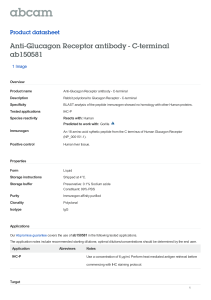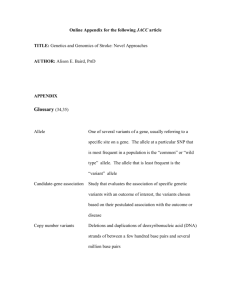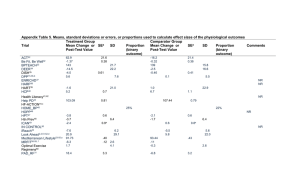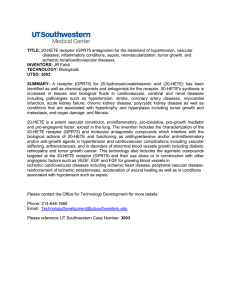Analysis of Gly40Ser polymorphism of the glucagon receptor (GCGR) gene RESEARCH LETTER
advertisement
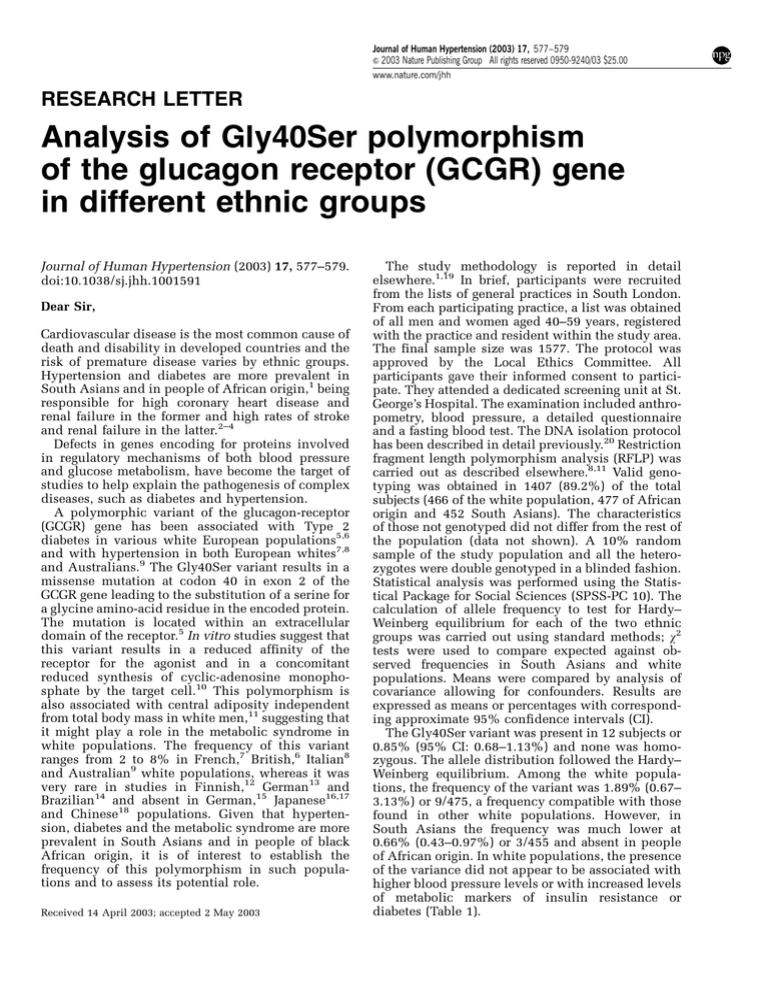
Journal of Human Hypertension (2003) 17, 577–579 & 2003 Nature Publishing Group All rights reserved 0950-9240/03 $25.00 www.nature.com/jhh RESEARCH LETTER Analysis of Gly40Ser polymorphism of the glucagon receptor (GCGR) gene in different ethnic groups Journal of Human Hypertension (2003) 17, 577–579. doi:10.1038/sj.jhh.1001591 Dear Sir, Cardiovascular disease is the most common cause of death and disability in developed countries and the risk of premature disease varies by ethnic groups. Hypertension and diabetes are more prevalent in South Asians and in people of African origin,1 being responsible for high coronary heart disease and renal failure in the former and high rates of stroke and renal failure in the latter.2–4 Defects in genes encoding for proteins involved in regulatory mechanisms of both blood pressure and glucose metabolism, have become the target of studies to help explain the pathogenesis of complex diseases, such as diabetes and hypertension. A polymorphic variant of the glucagon-receptor (GCGR) gene has been associated with Type 2 diabetes in various white European populations5,6 and with hypertension in both European whites7,8 and Australians.9 The Gly40Ser variant results in a missense mutation at codon 40 in exon 2 of the GCGR gene leading to the substitution of a serine for a glycine amino-acid residue in the encoded protein. The mutation is located within an extracellular domain of the receptor.5 In vitro studies suggest that this variant results in a reduced affinity of the receptor for the agonist and in a concomitant reduced synthesis of cyclic-adenosine monophosphate by the target cell.10 This polymorphism is also associated with central adiposity independent from total body mass in white men,11 suggesting that it might play a role in the metabolic syndrome in white populations. The frequency of this variant ranges from 2 to 8% in French,7 British,6 Italian8 and Australian9 white populations, whereas it was very rare in studies in Finnish,12 German13 and Brazilian14 and absent in German,15 Japanese16,17 and Chinese18 populations. Given that hypertension, diabetes and the metabolic syndrome are more prevalent in South Asians and in people of black African origin, it is of interest to establish the frequency of this polymorphism in such populations and to assess its potential role. Received 14 April 2003; accepted 2 May 2003 The study methodology is reported in detail elsewhere.1,19 In brief, participants were recruited from the lists of general practices in South London. From each participating practice, a list was obtained of all men and women aged 40–59 years, registered with the practice and resident within the study area. The final sample size was 1577. The protocol was approved by the Local Ethics Committee. All participants gave their informed consent to participate. They attended a dedicated screening unit at St. George’s Hospital. The examination included anthropometry, blood pressure, a detailed questionnaire and a fasting blood test. The DNA isolation protocol has been described in detail previously.20 Restriction fragment length polymorphism analysis (RFLP) was carried out as described elsewhere.8,11 Valid genotyping was obtained in 1407 (89.2%) of the total subjects (466 of the white population, 477 of African origin and 452 South Asians). The characteristics of those not genotyped did not differ from the rest of the population (data not shown). A 10% random sample of the study population and all the heterozygotes were double genotyped in a blinded fashion. Statistical analysis was performed using the Statistical Package for Social Sciences (SPSS-PC 10). The calculation of allele frequency to test for Hardy– Weinberg equilibrium for each of the two ethnic groups was carried out using standard methods; w2 tests were used to compare expected against observed frequencies in South Asians and white populations. Means were compared by analysis of covariance allowing for confounders. Results are expressed as means or percentages with corresponding approximate 95% confidence intervals (CI). The Gly40Ser variant was present in 12 subjects or 0.85% (95% CI: 0.68–1.13%) and none was homozygous. The allele distribution followed the Hardy– Weinberg equilibrium. Among the white populations, the frequency of the variant was 1.89% (0.67– 3.13%) or 9/475, a frequency compatible with those found in other white populations. However, in South Asians the frequency was much lower at 0.66% (0.43–0.97%) or 3/455 and absent in people of African origin. In white populations, the presence of the variance did not appear to be associated with higher blood pressure levels or with increased levels of metabolic markers of insulin resistance or diabetes (Table 1). Research Letter 578 Table 1 Age- and sex-adjusted characteristics by GCGR gene polymorphism in whites Gly40Gly (n=407) Systolic BP (mmHg) Diastolic BP (mmHg) Body mass index (kg/m2) Waist circumference (cm) Hip circumference (cm) Waist-to-hip ratio Serum triglycerides (mmol/l)a Total cholesterol (mmol/l) HDL-cholesterol (mmol/l)a Serum insulin (fasting) (pmol/l)a Serum glucose (fasting) (mmol/l) HOMA indexa,b Serum uric acid (mmol/l) Gly40Ser (n=9) 125.4 (123.6–127.1) 79.5 (78.6–80.5) 25.9 (25.5–26.4) 87.12 (86.1–88.2) 101.1 (100.2–101.9) 0.86 (0.85–0.87) 1.22 (1.16–1.28) 6.21 (6.10–6.32) 1.34 (1.44–1.37) 6.82 (6.42–7.24) 5.10 (5.01–5.19) 1.53 (1.43–1.64) 284 (278–291) 121.7 (110.2–133.2) 79.2 (72.9–85.5) 25.6 (22.6–28.7) 85.0 (77.7–92.3) 101.4 (95.9–106.9) 0.84 (0.79–0.88) 0.82 (1.80–1.14) 6.38 (5.63–7.13) 1.55 (1.30–1.86) 6.34 (4.26–9.39) 4.87 (4.25–5.49) 1.37 (0.88–2.12) 272 (228–317) P 0.537 0.919 0.848 0.564 0.895 0.265 0.021 0.659 0.095 0.723 0.474 0.830 0.596 Mean (95% CI). a Geometric means. b Homeostasis model assessment (HOMA) index calculated as: fasting serum insulin (mmol/l) fasting serum glucose (mmol/l)/22.5. The present study confirms that in a white British population, the frequency of the Gly40Ser variant of the GRCG gene is not very common and only accounts for not more than 3%. These figures are compatible with those reported in other studies on white populations in Europe5–8,10,12,13 and elsewhere.14 Conversely, our study reveals that the Gly40Ser variant of the GCGR was absent in a sample of adult men and women of black African origin and very rare in a comparable sample of South Asian men and women. The link of this genetic variant to the development of hypertension is postulated through the involvement of both glucagon21 and c-AMP metabolism.22 Glucagon may have a natriuretic effect through stimulation of hepatic c-AMP, increased levels of circulating c-AMP and a reduction of solute and water reabsorption in the pars recta of the renal proximal tubule.22 The polymorphic variant of the receptor, which is less sensitive to agonist stimulation and results in a lower production of c-AMP by the liver cells, would induce sodium and water retention and hypertension. This hypothesis could explain the recently reported reduced fractional excretion of exogenous lithium and uric acid in white men carrying the Gly40Ser variant.8 On the other hand, the link of this genetic variant to the development of diabetes is postulated through either a less responsive receptor to endogenous glucagon to protect against hyperglycaemia,5,10 or through stimulation of insulin production in response to glucagon binding to pancreatic islet betacells.23 Considering the high prevalence of hypertension and diabetes among South Asians and people of black African origin,1 it is unlikely that this variant plays an important role in the development of these two common diseases in these two ethnic groups. Indeed, given the very low population frequency, the potential population attributable risk would be negligible.24 Journal of Human Hypertension Acknowledgements We thank Professor Pasquale Strazzullo for useful comments. AB holds a ‘Salvatore Campus’ Fellowship of the Italian Society of Hypertension. The Wandsworth Heart & Stroke Study has received support from the Wandsworth Health Authority, the South West Thames Regional Health Authority, the NHS R&D Directorate, the British Heart Foundation, the British Diabetic Association and The Stroke Association. FPC is a member of the St George’s Cardiovascular Research Group. A Barbato1, P Russo2, A Venezia2, V Strazzullo3 A Siani2 and FP Cappuccio1 1 Department of Community Health Sciences, St George’s Hospital Medical School, London, UK 2 Epidemiology & Population Genetics, Institute of Food Sciences, National Research Council of Italy, Avellino, Italy 3 Department of Clinical & Experimental Medicine, ‘Federico II’ University of Naples, Naples, Italy Correspondence: FP Cappuccio E-mail: f.cappuccio@sghms.ac.uk References 1 Cappuccio FP, Cook DG, Atkinson RW, Strazzullo P. Prevalence, detection, and management of cardiovascular risk factors in different ethnic groups in south London. Heart 1997; 78: 555–563. 2 Balarajan R. Ethnic differences in mortality from ischaemic heart disease and cerebrovascular disease in England and Wales. BMJ 1991; 302: 560–564. 3 Roderick PJ et al. Population need for renal replacement therapy in Thames regions: ethnic dimension. BMJ 1994; 309: 1111–1114. 4 Raleigh VS. Diabetes and hypertension in Britain’s ethnic minorities: implications for the future of renal services. BMJ 1997; 314: 209–213. Research Letter 5 Hager J et al. A missense mutation in the glucagon receptor gene is associated with non-insulin-dependent diabetes mellitus. Nat Genet 1995; 9: 299–304. 6 Gough SC et al. Mutation of the glucagon receptor gene and diabetes mellitus in the UK: association or founder effect? Hum Mol Genet 1995; 4: 1609–1612. 7 Brand E, Bankir L, Plouin PF, Soubrier F. Glucagon receptor gene mutation (Gly40Ser) in human essential hypertension: the PEGASE study. Hypertension 1999; 34: 15–17. 8 Strazzullo P et al. Altered renal sodium handling and hypertension in men carrying the glucagon receptor gene (Gly40Ser) variant. J Mol Med 2001; 79: 574–580. 9 Chambers SM, Morris BJ. Glucagon receptor gene mutation in essential hypertension. Nat Genet 1996; 12: 122. 10 Hansen LH et al. The Gly40Ser mutation in the human glucagon receptor gene associated with NIDDM results in a receptor with reduced sensitivity to glucagon. Diabetes 1996; 45: 725–730. 11 Siani A et al. Gly40Ser polymorphism of the glucagon receptor gene is associated with central adiposity in men. Obes Res 2001; 9: 722–726. 12 Huang X, Orho M, Lehto M, Groop L. Lack of association between the Gly40Ser polymorphism in the glucagon receptor gene and NIDDM in Finland. Diabetologia 1995; 38: 1246– 1248. 13 Ambrosch A et al. Analysis of the Gly40Ser polymorphism in the glucagon receptor gene in a German non-insulin-dependent diabetes mellitus population. Clin Chem Lab Med 1999; 37: 719–721. 14 Shiota D et al. Role of the Gly40Ser mutation in the glucagon receptor gene in Brazilian patients with type 2 diabetes mellitus. Pancreas 2002; 24: 386–390. 15 Ristow M, Busch K, Schatz H, Pfeiffer A. Restricted geographical extension of the association of a glucagon receptor gene 16 17 18 19 20 21 22 23 24 mutation (Gly40Ser) with non-insulin-dependent diabetes mellitus. Diabetes Res Clin Pract 1996; 32: 183–185. Ogata M et al. Absence of the Gly40-ser mutation in the glucagon receptor gene in Japanese subjects with NIDDM. Diabetes Res Clin Pract 1996; 33: 71–74. Odawara M, Tachi Y, Yamashita K. Absence of association between the Gly40-Ser mutation in the human glucagon receptor and Japanese patients with non-insulin-dependent diabetes mellitus or impaired glucose tolerance. Hum Genet 1996; 98: 636–639. Deng H, Tang WL, Pan Q. Gly40Ser mutation of glucagon receptor gene and NIDDM in Han nationality. Hunan Yi Ke Da Xue Xue Bao 2001; 26: 291–293. Cappuccio FP, Cook DG, Atkinson RW, Wicks PD. The Wandsworth Heart and Stroke Study. A population-based survey of cardiovascular risk factors in different ethnic groups. Methods and baseline findings. Nutr Metab Cardiovasc Dis 1998; 8: 371–385. Sagnella GA et al. A population study of ethnic variations in the angiotensin-converting enzyme I/D polymorphism: relationships with gender, hypertension and impaired glucose metabolism. J Hypertens 1999; 17: 657–664. Morris BJ, Chambers SM. Hypothesis: glucagon receptor glycine to serine missense mutation contributes to one in 20 cases of essential hypertension. Clin Exp Pharmacol Physiol 1996; 23: 1035–1037. Ahloulay M et al. Cyclic AMP is a hepatorenal link influencing natriuresis and contributing to glucagon-induced hyperfiltration in rats. J Clin Invest 1996; 98: 2251–2258. Van Schravendijk CF et al. Pancreatic hormone receptors on islet cells. Endocrinology 1985; 117: 841–848. Cappuccio FP, Sagnella GA, MacGregor GA. Association studies of genetic polymorphisms and complex disease. Lancet 2000; 355: 1278. 579 Journal of Human Hypertension


